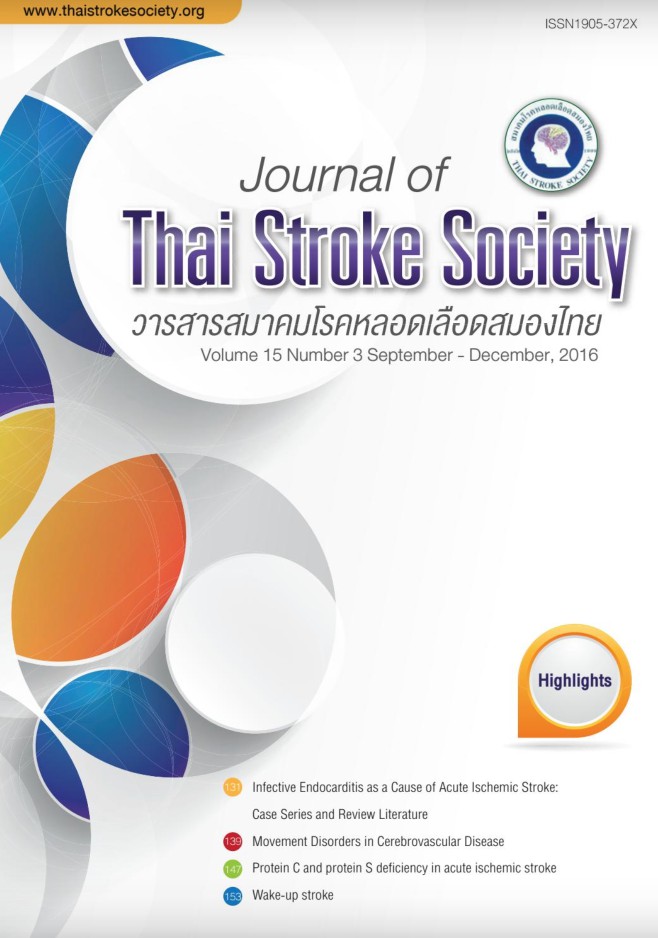Movement Disorders in Cerebrovascular Disease
Keywords:
Movement disorders, cerebrovascular disease, stroke, parkinsonism, chorea, tremorAbstract
Movement disorders secondary to cerebrovascular diseases are common and differ from their idiopathic or genetic disease in terms of clinical presentation, natural history, prognosis, and treatment. They occur frequently when the lesions involve the basal ganglia, thalamus, cerebellum, or their connections. Poststroke movement disorders can manifest in a wide range of movement disorders including parkinsonism, chorea, ballism, athetosis, dystonia, tremor, myoclonus, and transient paroxysmal hyperkinesia. Also, they can occur as a presenting symptom immediately after stroke or appear as a later manifestation. Despite the low tendency to resolve and difficulty in treatment, the recognition of movement disorders in the setting of cerebrovascular disease is important in lesion localization and suggesting an underlying etiology.
References
Ghika-Schmid F, Ghika J, Regli F, Bogousslavsky J. Hyperkinetic movement disorders during and after acute stroke: the Lausanne Stroke Registry. J Neurol
Sci. 1997 Mar 10;146(2):109-16.
Holtbernd F, Eidelberg D. Functional brain networks in movement disorders: recent advances. Curr Opin Neurol. 2012 Aug;25(4):392-401.
Choi SM. Movement Disorders Following Cerebrovascular Lesions in Cerebellar Circuits. J Mov Disord. 2016 May;9(2):80-8.
Scott BL, Jankovic J. Delayed-onset progressive movement disorders after static brain lesions. Neurology. 1996 Jan;46(1):68-74.
Alarcon F, Zijlmans JC, Duenas G, Cevallos N. Poststroke movement disorders: report of 56 patients. J Neurol Neurosurg Psychiatry. 2004 Nov;75(11):1568-74.
Thanvi B, Lo N, Robinson T. Vascular parkinsonism--an important cause of parkinsonism in older people. Age Ageing. 2005 Mar;34(2):114-9.
Gupta D, Kuruvilla A. Vascular parkinsonism: what makes it different? Postgrad Med J. 2011 Dec;87(1034):829-36.
FitzGerald PM, Jankovic J. Lower body parkinsonism: evidence for vascular etiology. Mov Disord. 1989;4(3):249-60.
Zijlmans J, Evans A, Fontes F, Katzenschlager R, Gacinovic S, Lees AJ, et al. [123I] FP-CIT spect study in vascular parkinsonism and Parkinson’s disease. Mov Disord. 2007 Jul 15;22(9):1278-85.
Demirkiran M, Bozdemir H, Sarica Y. Vascular parkinsonism: a distinct, heterogeneous clinical entity. Acta Neurol Scand. 2001 Aug;104(2):63-7.
Lin JJ, Chang MK. Hemiballism-hemichorea and non-ketotic hyperglycaemia. J Neurol Neurosurg Psychiatry. 1994 Jun;57(6):748-50.
Chuang C, Fahn S, Frucht SJ. The natural history and treatment of acquired hemidystonia: report of 33 cases and review of the literature. J Neurol Neurosurg
Psychiatry. 2002 Jan;72(1):59-67.
Marsden CD, Obeso JA, Zarranz JJ, Lang AE. The anatomical basis of symptomatic hemidystonia. Brain. 1985 Jun;108 ( Pt 2):463-83.
Baysal L, Acarer A, Celebisoy N. Post-ischemic Holmes’ tremor of the lower extremities. J Neurol. 2009 Dec;256(12):2079-81.
Deuschl G, Toro C, Valls-Sole J, Zeffiro T, Zee DS, Hallett M. Symptomatic and essential palatal tremor. 1. Clinical, physiological and MRI analysis.
Brain. 1994 Aug;117 ( Pt 4):775-88.
Goyal M, Versnick E, Tuite P, Cyr JS, Kucharczyk W, Montanera W, et al. Hypertrophic olivary degeneration: metaanalysis of the temporal evolution
of MR findings. AJNR Am J Neuroradiol. 2000 Jun-Jul;21(6):1073-7.
Kim JS. Asterixis after unilateral stroke: lesion location of 30 patients. Neurology. 2001 Feb 27;56(4):533-6.
Bansil S, Prakash N, Kaye J, Wrigley S, Manata C, Stevens-Haas C, et al. Movement disorders after stroke in adults: a review. Tremor Other Hyperkinet
Mov (N Y). 2012;2.
Ali S, Khan MA, Khealani B. Limb-shaking Transient Ischemic Attacks: case report and review of literature. BMC Neurol. 2006;6:5.
Park J. Movement Disorders Following Cerebrovascular Lesion in the Basal Ganglia Circuit. J Mov Disord. 2016 May;9(2):71-9.
Downloads
Published
How to Cite
Issue
Section
License
ข้อความภายในบทความที่ตีพิมพ์ในวารสารสมาคมโรคหลอดเลือดสมองไทยเล่มนี้ ตลอดจนความรับผิดชอบด้านเนื้อหาและการตรวจร่างบทความเป็นของผู้นิพนธ์ ไม่เกี่ยวข้องกับกองบรรณาธิการแต่อย่างใด การนำเนื้อหา ข้อความหรือข้อคิดเห็นของบทความไปเผยแพร่ ต้องได้รับอนุญาตจากกองบรรณาธิการอย่างเป็นลายลักษณ์อักษร ผลงานที่ได้รับการตีพิมพ์ในวารสารเล่มนี้ถือเป็นลิขสิทธิ์ของวารสาร





